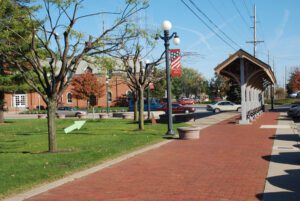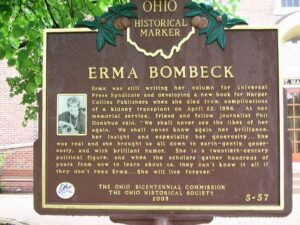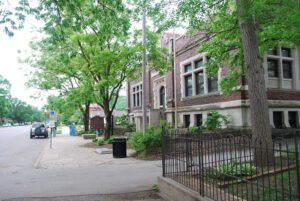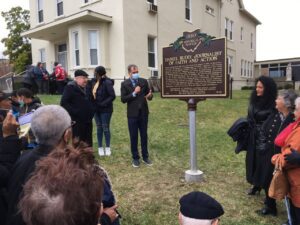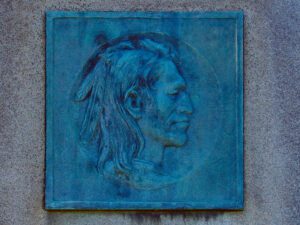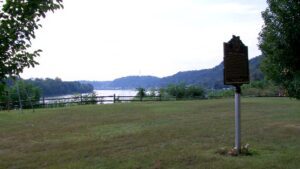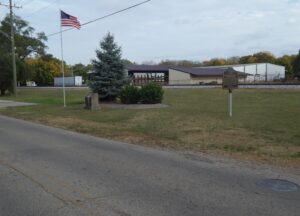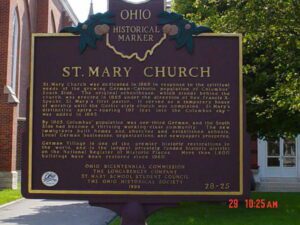, OH
Sherwood Anderson (1876-1941), author of 27 works, gave up a successful business career in Elyria, Ohio, to concentrate on writing. Born in Camden, Anderson spent his formative years (1884-1895) in Clyde, and in 1919 he published his most notable book, Winesburg, Ohio. Clyde and small-town Ohio inspired many of its tales. Critics also praised his short story collections, including The Triumph of the Egg (1921) and Death in the Woods (1933). Commercially successful as a writer, Anderson moved to rural Virginia, where in 1927 he purchased and operated two newspapers while continuing his literary career. Through his writings and encouragement he was a major influence to a younger generation of writers, including William Faulkner, Ernest Hemingway, and John Steinbeck. Sherwood Anderson is buried in Marion, Virginia.
, OH
Erma Fiste was born in Dayton on February 21, 1927. While attending Patterson Cooperative High School, she worked as a copygirl for the Dayton Herald. After graduating from the University of Dayton in 1949, she married Bill Bombeck. She returned to the Dayton Journal-Herald as a reporter. Four years later she left the paper to raise three children, Betsy, Andy and Matt. She continued to write part-time from home. In 1965, Glenn Thompson of the Dayton Journal-Herald spotted her column in the Kettering-Oakwood Times and offered her a twice-a-week column. After three weeks he brought it to the attention of Newsday Syndicate. “At Wit’s End” grew to become nationally syndicated in over 900 newspapers. Erma wrote twelve books; nine made The New York Times Best Sellers List. In 1975 she joined the original cast of “Good Morning America” on ABC-TV and appeared regularly for eleven years.
, OH
Born in Chillicothe in 1872, Burton Stevenson’s life was devoted to the written word as a prolific author and anthologist, and as a librarian. Following stints as a journalist while a student at Princeton University and then at newspapers in Chillicothe, Stevenson became the librarian of the city’s public library in 1899. He held the post for 58 years. Stevenson helped secure a Carnegie Library for Chillicothe, completed in 1906, and became prominent for his service during World War I. He founded a library at Camp Sherman (an army training camp north of the city), which became a model for others nationally.
, OH
Daniel Arthur Rudd was born into slavery on August 7, 1854, in Bardstown, Kentucky. He became a newspaperman, lecturer, publicist, and tireless advocate for the Roman Catholic Church. After the Civil War Rudd moved to Springfield. Baptized and raised in Catholicism, he joined St. Raphael Parish, where the philosophy of racial equality offered by the church solidified his vision of justice. By 1885 he had established his own weekly newspaper, The Ohio State Tribune. He rebranded it The American Catholic Tribune (ACT) after moving to Cincinnati. Rudd claimed ACT was the only Catholic newspaper owned by an African American. At the height of its popularity in 1892, the publication had a circulation of 10,000. In 1893 Rudd was asked to chair the Afro-American Press Association, representing more than 200 black-owned newspapers.
, OH
Tah-gah-jute, the Mingo chief named Logan, was a native of Pennsylvania. Logan moved to Ohio in 1770, and settled at the Pickaway Plains. Logan and his father, Shikellimus, had long supported friendships between Native Americans and white men; however, in the spring of 1774, his tribesmen and family were murdered at Yellow Creek, along the Ohio River. Once an advocate of peace, Logan went on the warpath and raided frontier settlements. These and similar raids along the Ohio frontier precipitated Lord Dunmore’s War in October 1774. After the Shawnees and their allies were defeated at Point Pleasant, Virginia governor Lord Dunmore marched up the Hocking River to the Pickaway Plains. Dunmore asked his interpreter, Colonel John Gibson, to assist in negotiations with Cornstalk and other Indian leaders, including Logan. Logan declined to attend the conference, but spoke to Gibson about his anger and betrayal.
, OH
James Edwin Campbell was born on September 28, 1867, in the Kerr’s Run area of Pomeroy to James and Letha Campbell. He graduated from Pomeroy High School with the class of 1884. After graduation, Campbell taught in various parts of Meigs County. Campbell achieved notoriety as an African American poet, editor, author of short stories, and educator. He began his writing in 1887 with the work Driftings and Gleanings. During the 1880s and 1890s, he wrote regularly for daily newspapers in Chicago and was employed on the literary staff of the Chicago Times-Herald. His dialect poetry attracted wide-spread popularity and he published a collection of his best works, Echoes From the Cabin and Elsewhere. Campbell was installed as the first president of the West Virginia Colored Institute (West Virginia State University), serving in the capacity from 1891 to 1894. James Edwin Campbell died in Pomeroy on January 26, 1896.
, OH
Carlisle Station Depot. The Carlisle depot for the Cincinnati, Hamilton & Dayton (CH&D) railroad was located nearby. The CH&D started operations in 1851 and was the second railroad through Warren County. Carlisle Station was a passenger and freight-shipping depot and was joined in 1872 by another, when Cincinnati & Springfield Railroad (later part of the Big Four and the New York Central Railroads) erected a depot in nearby Franklin. Carlisle was originally known as the “Jersey Settlement,” because many settlers in the early 1800s were from New Jersey. George Carlisle, vice-president of the CH&D, purchased a large tract of land here. After Carlisle and his wife Sarah donated a lot to the community in 1856, residents renamed the place “Carlisle Station.” The Carlisle Literary Association built a hall on the lot c. 1856, which, as of 2019, remains as the older section of Carlisle’s municipal building. Side B: Schenck-Stanton Rally, October 3, 1868.
, OH
St. Mary Church was dedicated in 1868 in response to the spiritual needs of the growing German-Catholic population of Columbus’ South Side. The original schoolhouse, which stands behind the church, was erected in 1865 under the direction of Rev. Francis X. Specht, St. Mary’s first pastor. It served as a temporary house of worship until the Gothic-style church was completed. St. Mary’s distinctive spire – soaring 197 feet into the Columbus sky – was added in 1893. By 1865, Columbus’ population was one-third German, and the South Side had become a thriving working-class community. The new immigrants built homes and churches and established schools. Local German businesses, organizations, and newspapers prospered. German Village is one of the premier historic restorations in the world, and is the largest privately funded historic district on the National Register of Historic Places. More than 1,600 buildings have been restored since 1960.


